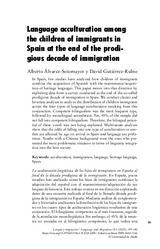Mostrar el registro sencillo del ítem
Language acculturation among the children of immigrants in Spain at the end of the prodigious decade of immigration
| dc.contributor.author | Álvarez Sotomayor, Alberto | |
| dc.contributor.author | Gutiérrez-Rubio, David | |
| dc.date.accessioned | 2024-02-05T11:40:56Z | |
| dc.date.available | 2024-02-05T11:40:56Z | |
| dc.date.issued | 2023 | |
| dc.identifier.issn | 2660-7166 | |
| dc.identifier.uri | http://hdl.handle.net/10396/27113 | |
| dc.description.abstract | In Spain, few studies have analyzed how children of immigrants combine the acquisition of Spanish with the maintenance/acquisi- tion of heritage languages. This paper moves into that direction by exploiting data from a survey conducted at the end of the so-called prodigious decade of immigration in Spain. We conduct cluster and bivariate analyses to analyze the distribution of children immigrants across the four types of language acculturation resulting from this conjunction. Competent bilingualism was the most frequent type, followed by monolingual assimilation. Yet, 45% of the sample did not fall into competent bilingualism. Therefore, the bilingual poten- tial of these youth was not being exploited. Multivariate analyses show that the odds of falling into one type of acculturation or ano- ther are affected by age on arrival in Spain and language use prefe- rence. Youths with a Chinese background were the ones who pre- sented the most problematic situation in terms of linguistic integra- tion into the host society | es_ES |
| dc.description.abstract | In Spain, few studies have analyzed how children of immigrants combine the acquisition of Spanish with the maintenance/acquisi- tion of heritage languages. This paper moves into that direction by exploiting data from a survey conducted at the end of the so-called prodigious decade of immigration in Spain. We conduct cluster and bivariate analyses to analyze the distribution of children immigrants across the four types of language acculturation resulting from this conjunction. Competent bilingualism was the most frequent type, followed by monolingual assimilation. Yet, 45% of the sample did not fall into competent bilingualism. Therefore, the bilingual poten- tial of these youth was not being exploited. Multivariate analyses show that the odds of falling into one type of acculturation or ano- ther are affected by age on arrival in Spain and language use prefe- rence. Youths with a Chinese background were the ones who pre- sented the most problematic situation in terms of linguistic integra- tion into the host society | es_ES |
| dc.format.mimetype | application/pdf | es_ES |
| dc.language.iso | eng | es_ES |
| dc.publisher | Editorial Universidad de Alcalá | es_ES |
| dc.rights | https://creativecommons.org/licenses/by-nc-nd/4.0/ | es_ES |
| dc.source | Álvarez-Sotomayor, A., & Gutiérrez-Rubio, D. (2023). Language acculturation among the children of immigrants in Spain at the end of the prodigious decade of immigration. Lengua y migración, 2(15), 161-184. https://doi.org/10.37536/LYM.2.15.2023.2258 | es_ES |
| dc.subject | Acculturation | es_ES |
| dc.subject | Immigration | es_ES |
| dc.subject | Language | es_ES |
| dc.subject | Heritage language | es_ES |
| dc.subject | Spain | es_ES |
| dc.subject | Aculturación | es_ES |
| dc.subject | Inmigración | es_ES |
| dc.subject | Lengua | es_ES |
| dc.subject | Lenguas de herencia | es_ES |
| dc.subject | España | es_ES |
| dc.title | Language acculturation among the children of immigrants in Spain at the end of the prodigious decade of immigration | es_ES |
| dc.title.alternative | La aculturación lingüística de los hijos de inmigrantes en España al final de la década prodigiosa de la inmigración | es_ES |
| dc.type | info:eu-repo/semantics/article | es_ES |
| dc.relation.publisherversion | https://doi.org/10.37536/LYM.2.15.2023.2258 | es_ES |
| dc.rights.accessRights | info:eu-repo/semantics/openAccess | es_ES |

